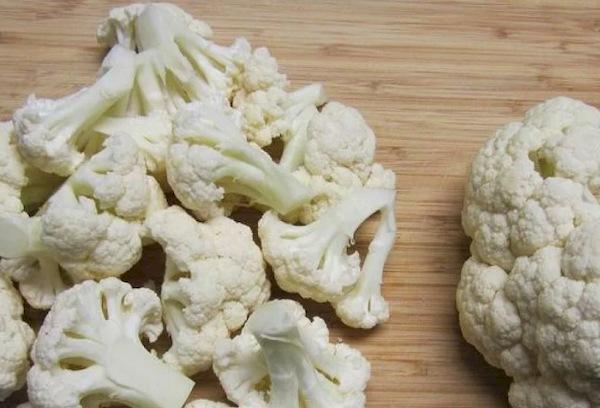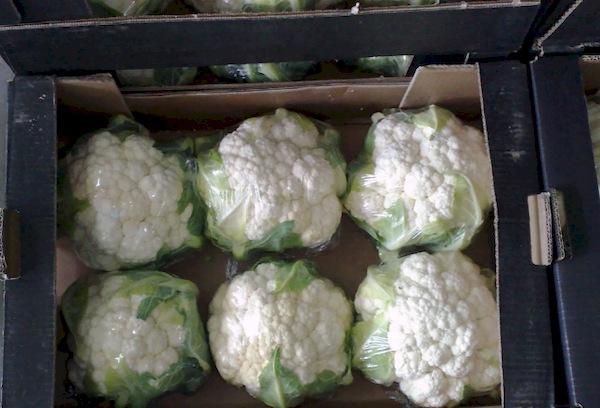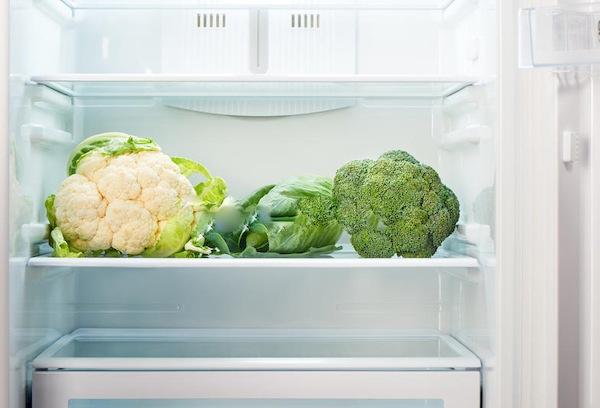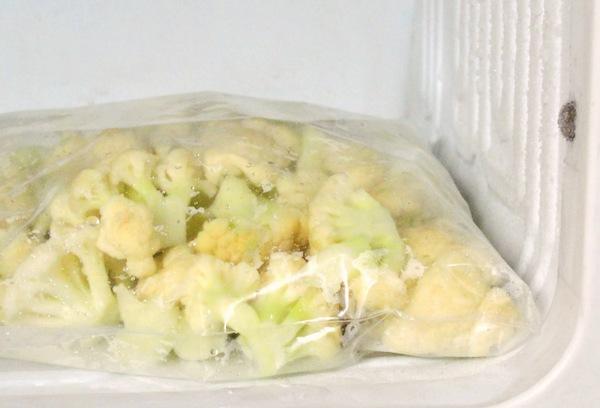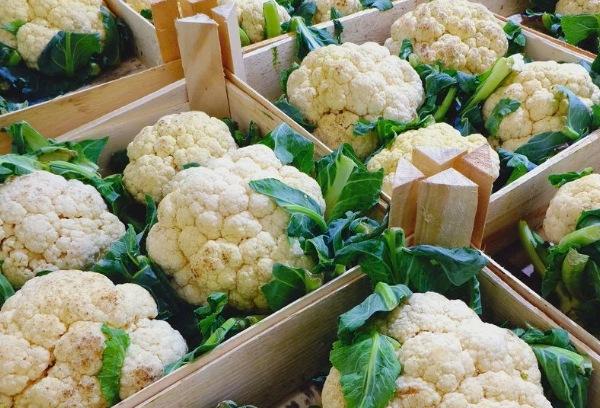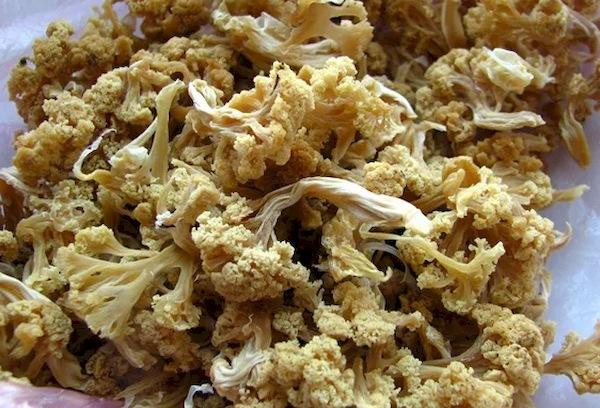How long can cauliflower be stored at home?
Content:
You can store fresh cauliflower in different ways. This vegetable is distinguished by the delicate structure of its inflorescences, so temperature conditions are important for storage. Those who do not have a cellar will have to take care of preparing a place for storing crops in the apartment. Cabbage can also be frozen - this method allows you not to worry about creating special conditions, the desired mode is maintained automatically.
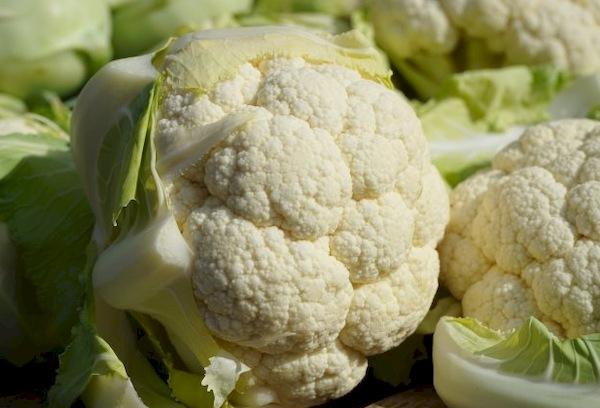
Preparing cauliflower for long-term storage
Before storing the harvest, it is sorted. Not all cauliflower will keep well. Heads of cabbage are selected according to several criteria:
- the cabbage must be clean, without signs of rotting or suspicious spots;
- normal color of inflorescences is white with a cream tint;
- the head of cabbage should be dense and elastic; density can be easily determined by weight.
When storing a whole head of cabbage, you should not tear off the top leaves; their presence will protect the inflorescences from drying out. Cabbage that has been grown using pesticides and chemical fertilizers cannot be stored for long periods of time.Residues of chemicals in the tissues will make the vegetable less shelf-stable, and its taste will be much worse.
The ability for long-term storage also depends on the variety of cauliflower. Vegetables with early ripening periods do not last long due to the high moisture content in the inflorescences. Mid-season varieties are best frozen. Late cauliflower can be successfully stored for several months.
Heads of cabbage intended for storage should not be kept in the garden; it is better to cut them when they are not ripe. Later, the cabbage will gradually ripen in storage. The head of cabbage must be complete. If it has broken down into separate inflorescences, it is better to process them or cook them.
Cauliflower intended for freezing and storage in the refrigerator is cleared of leaves and roots, disassembled into inflorescences, washed and dried. If you need to store 1-2 heads in the refrigerator, they do not need to be divided into parts.
How long does cauliflower last?
Shelf life depends on the variety, quality and stage of maturity of the cabbage itself. In addition, suitable storage conditions must be provided. Maximum shelf life of a vegetable is ensured if:
- the temperature regime is maintained in the range from 0° to +6° C;
- cabbage is stored without access to light;
- there is good air exchange in the storage;
- stable humidity is ensured at 95%;
- the heads of cabbage do not touch each other.
Fresh cabbage lasts the longest in the cellar - up to 2 months. If unripe heads are buried, they will continue to grow, which will extend the shelf life to 5-6 months. Frozen vegetables do not lose their quality for up to a year. Fresh heads will keep in the refrigerator for 2-3 weeks.
3 main ways to store cauliflower
It is not so easy to find places in the apartment where the temperature does not rise above +6° C.Even if we consider a glazed balcony, there is also no stable temperature regime there. At home, the only way to keep cauliflower fresh is by putting it in the refrigerator.
The lucky owners of the cellar are lucky - cabbage can be stored in such storage for up to six months. However, this period may be shorter, it all depends on the chosen storage method.
In the cellar
If you want to have fresh cauliflower on hand during the winter, it is best to store it in the cellar. The heads will last the longest if you dig them up with their roots, tear off the top leaves and immerse them in a box with damp, cleaned sand. Periodically, it is necessary to inspect the heads of cabbage, removing damaged specimens, if any are found, and lightly moisten the sand. In this form, the vegetable will retain its original appearance for 5-6 months.
Other storage options are also acceptable, but when using them, the cabbage will lie less:
- In a clay shell. The heads of cabbage can be coated with liquid clay and allowed to dry. The cabbage should be completely covered with the clay mass. After the clay has dried, the heads are laid out on shelves with a small gap. In the next 4 months you won’t have to worry about the safety of the harvest. The vegetable will need to be washed thoroughly before use.
- In boxes. The container is filled with heads of cabbage wrapped in paper or cling film. A small distance is left between the heads for free passage of air. If the harvest is large, you don’t have to wrap the cabbage individually, but cover the box with film, preventing moisture evaporation.
- Hanging. This method allows you to save space in storage for other vegetables.A strong rope or wire is stretched under the ceiling, where heads of cauliflower will be suspended in nylon nets. You can secure the cabbage in another way by tying strings to the stalks. The top leaves need to be removed. This method allows you to preserve the grown product for a month.
The cellar is a suitable place for growing heads of cabbage. If frost hits and the cabbage is not yet ripe, it is transplanted into containers with soil and continued to be watered. In such conditions, the vegetable will not only be stored, but will also continue to increase in size. The temperature in this case may be slightly higher – from +4° to +10° C.
In a refrigerator
To save space in the refrigerator, before storage, cabbage can be disassembled into inflorescences, washed, dried and placed in the vegetable compartment, packaged in bags and sprinkled with salt. In the upper part of the bags, several holes are made with a toothpick for air access.
When laying whole heads of cabbage, they are wrapped in paper or two layers of cling film, having previously been freed from covering leaves. In this form, the product can be stored in any part of the refrigerator, but it is better to reserve it on the bottom shelf, where it is cooler.
Due to the ability of this vegetable to retain moisture well, condensation does not form under the film, which is a significant advantage during storage. Tender cauliflower is unlikely to last longer than 3 weeks, even at low temperatures in the refrigerator. The vegetable is periodically taken out and checked for spoilage.
In the freezer
Cauliflower can last the longest in the freezer. The reserves will definitely not spoil before the next harvest. Heads of cabbage can be stored whole or disassembled. The methods of processing individual inflorescences also differ.The vegetable can be stored fresh or pre-blanched.
Blanching steps:
- before subjecting cabbage to heat treatment, it is washed, cleared of leaves, divided into parts, the size of the divided inflorescences should be convenient for subsequent cooking;
- then the vegetable is immersed in boiling water, wait until it boils again and blanch for 3 minutes;
- after a short cooking, the product is transferred to a colander and washed under running cold water;
- Blanched and cooled inflorescences are placed on a paper towel and dried to remove excess moisture.
The cabbage prepared in this way is laid out in one layer on a wide tray and put in the freezer for pre-freezing (if you remove the vegetable right away, the inflorescences will stick together). After 20-30 minutes, the vegetable preparation is transferred to plastic containers with a lid or bags.
Fresh vegetables are prepared for freezing in the same way, bypassing the blanching stage. The advantage of modern refrigerators is the ability to set a certain temperature in them. At -18° C, cauliflower will be stored for the longest possible time – up to 1 year. If in the freezer -12° C, the shelf life is reduced to 1.5 months.
Defrosting and then re-freezing vegetables is unacceptable. In this case, the product loses all its beneficial properties and taste, becomes soggy and soft. Vegetables from the freezer will cook faster.
The taste of a product frozen according to the rules and stored at a stable temperature is preserved. It can be used for baby and diet food, since most of the vitamins are preserved when frozen. Cabbage removed from the freezer should be cooked the same day.
What other way can you preserve cauliflower?
Cauliflower is considered a difficult vegetable to store. In addition to the main methods, some use other options so that the harvest does not go to waste:
On the balcony
If you have a glazed balcony, you can put the cabbage there after harvesting. In an apartment, vegetables are usually stored in boxes or large cardboard boxes.
It must be taken into account that in such conditions it is impossible to maintain a stable temperature, since the temperature indicator largely depends on the weather outside the window. Therefore, we cannot talk about long storage periods. In this case, the keeping quality of the heads of cabbage will remain at a height of no more than 4 weeks.
Dried
Drying is a less popular, but also used method of preserving the cauliflower harvest. You must understand in advance that in this case the taste of the vegetable will be noticeably modified. The preparation of the product for drying is the same as for freezing.
The washed and dried inflorescences are laid out on a baking sheet and dried in the oven with the door ajar at a temperature of 60° C for about 4-5 hours. Store the product in closed jars away from light. In winter, the preparation can be added to vegetable soups and stews, combined with fresh vegetables - zucchini, potatoes, eggplants, tomatoes.
Recommendations for storing cauliflower
Due to the fact that the vegetable pulp is very tender, if the temperature regime fails, the safety of the product is easily lost. If the temperature is below 0° C, the heads of cabbage will freeze. When the upper threshold is exceeded (+5-6° C), the vegetable will begin to sprout. That is why it is best to store cabbage in places with a stable temperature - refrigerator, freezer, cellar.
Whole heads of cabbage must have individual packaging (film, paper). The inflorescences are packaged in bags, glass jars, containers, divided into portions. The forks should not touch each other, then they will last longer. It has been noticed that cabbage overfed with nitrogen does not store well - summer residents should also take this into account.
Only heads from which excess moisture has been removed after washing are suitable for storage. The vegetable will last longer in complete darkness with good ventilation. If the cabbage was collected during fog or rain, the heads of cabbage are laid out under a canopy, covered with a light cloth for pre-drying.
Whatever method of preserving cauliflower is chosen, you should not exceed the recommended storage time. In this case, the taste of the vegetable deteriorates noticeably, the inflorescences become bitter. The first signs of spoilage will be dark spots on the surface of the head of cabbage or its noticeable yellowing. You should not eat spoiled cabbage; in this case, you will not get any pleasure or benefit from it.
